Gardening in Zone 5, where winters are colder than a polar bear’s nose and the growing season is shorter than your attention span during a dull meeting, can be quite the challenge!
But fear not, for we’ve got a list of hardy evergreen shrubs that will bring year-round beauty to your garden. Now, let’s put on our gardening gloves and dive into the frosty world of Zone 5 evergreens that’ll make even your neighbor’s plastic flamingo jealous!
Understanding Zone 5
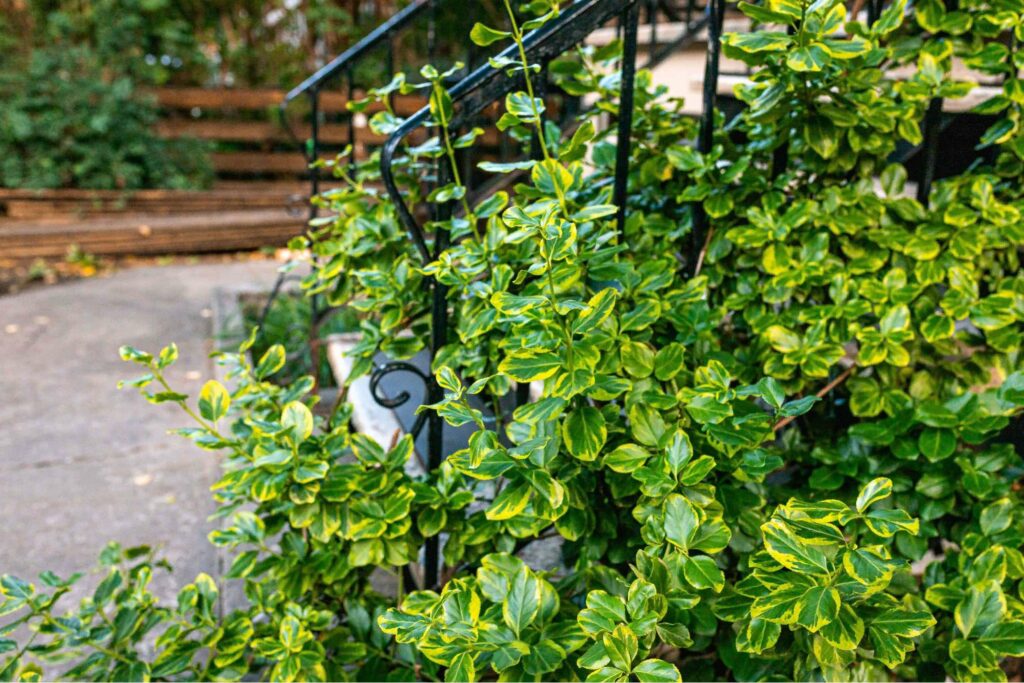
Zone 5, as per the USDA Plant Hardiness Zone Map, means cold winters and a short growing season. It covers areas where winter temperatures can go as low as -20ºF (-7ºC*), including parts of the Midwest, Northeast, and some higher Western elevations.
The winters are pretty harsh with freezing temperatures, heavy snow, and icy winds, posing difficulties for plants and gardeners. Due to the lengthy cold season, there’s limited time for gardening in this zone.
When living in this zone, you’ll have to be pretty efficient in making use of the warmer months. Also, Zone 5 experiences unpredictable weather with temperature changes throughout the year, making plant selection tricky.
Top 25 Evergreen Shrubs for Zone 5
Boxwood (Buxus spp.)
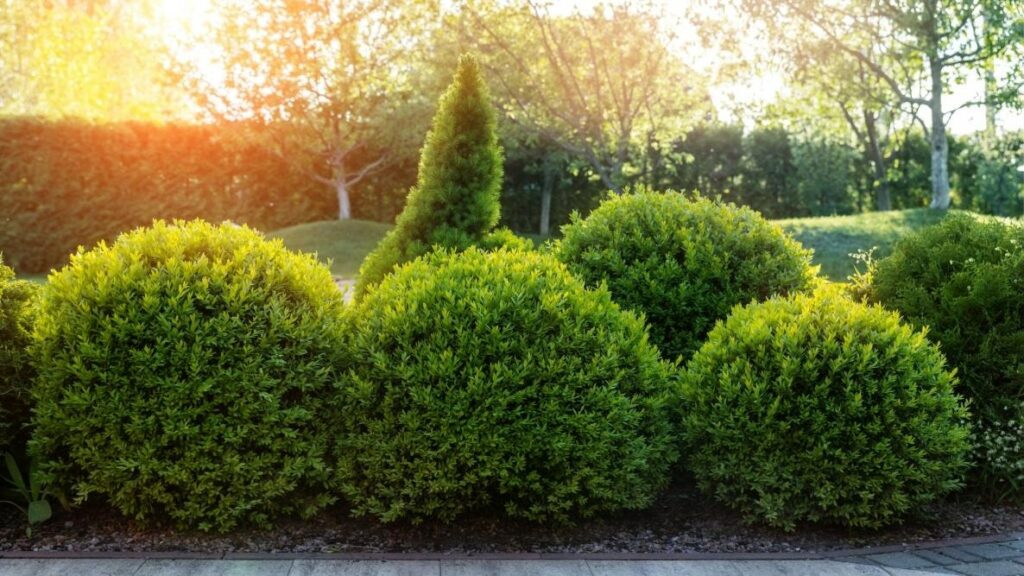
| Factor | Description |
| Ease of Growing | Easy ●○○○○ |
| Family | Buxaceae |
| Distinctive Features | Versatile cultivars, various sizes, dense evergreen foliage. |
| Possible Issues | Susceptible to boxwood blight, over-pruning can lead to dieback. |
Boxwoods are suitable for all gardeners, including beginners, as they require minimal maintenance. These shrubs are valued for their dense, evergreen foliage, providing year-round greenery and privacy when used as hedges.
When it comes to growing boxwoods, they do well in soil that drains properly and like some sunlight. Trimming them helps them keep their shape and thickness.
Keep an eye out for boxwood blight and act quickly if you see it to protect your shrubs. Taking good care of them by watering and fertilizing regularly ensures they stay healthy and last a long time in your garden.
Yew (Taxus spp.)
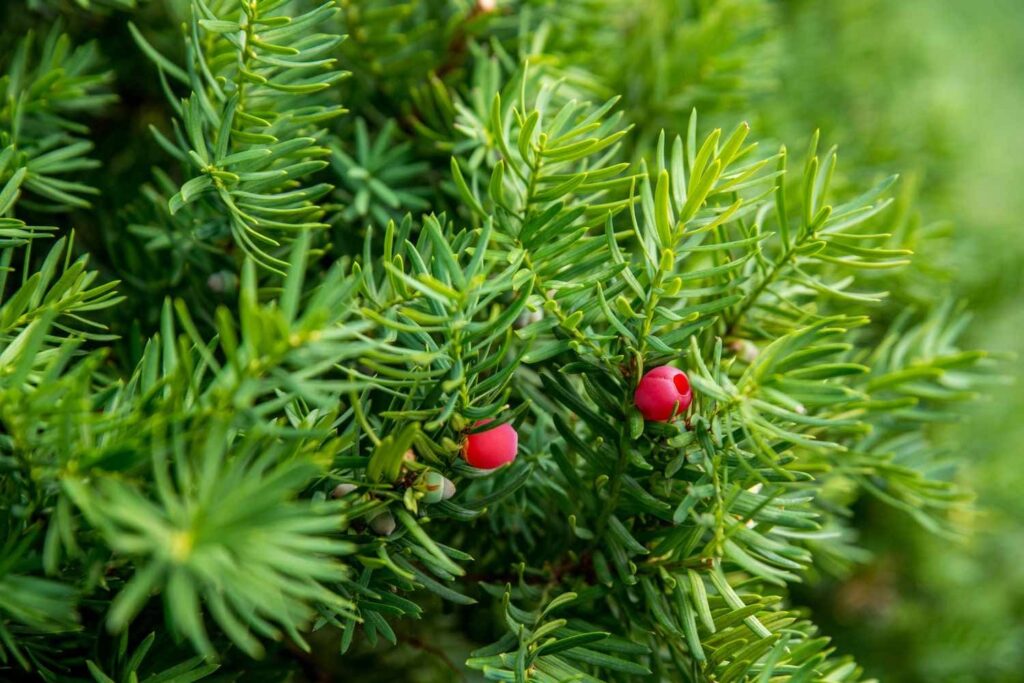
| Factor | Description |
| Ease of Growing | Easy ●○○○○ |
| Family | Taxaceae |
| Distinctive Features | Dark green needles, shade tolerance, suitability for hedges and topiaries |
| Possible Issues | Toxicity (all parts of the plant are toxic if ingested) |
Yews can thrive in various garden locations, including shaded areas. Yews can also be shaped into hedges or topiaries.
However, yews are toxic. Every part of the plant, including the needles and berries, contains harmful compounds if ingested.
If you’re thinking of planting yews in your garden, be especially careful if you have children or pets running around.
Juniper (Juniperus spp.)
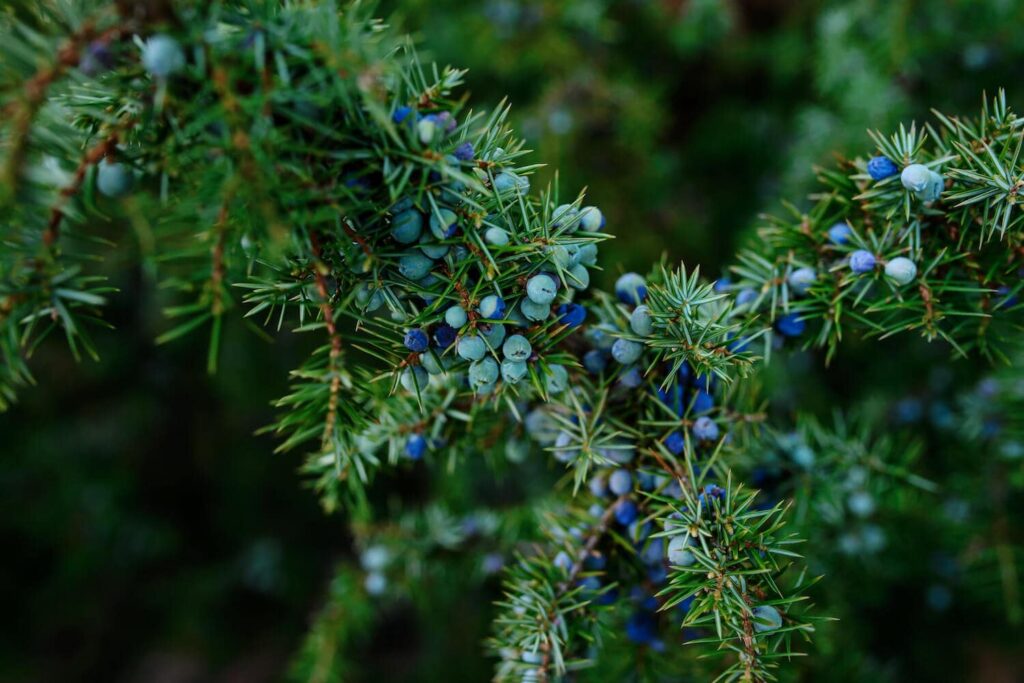
| Factor | Description |
| Ease of Growing | Easy ●○○○○ |
| Family | Cupressaceae |
| Distinctive Features | Scale-like leaves, various sizes and shapes, drought tolerance, berry-like cones |
| Possible Issues | Susceptible to pests and diseases, may become invasive in some regions |
Junipers do well in full sunlight but can also handle partial shade. They prefer well-draining soil, but many types can grow in different soil types, like sandy or rocky soil.
Once established, junipers can handle drought and need minimal watering. But during the first year after planting, water them regularly to help their roots grow strong.
Junipers respond well to pruning, which can help them keep their shape and size. Their small cone-like berries add visual appeal to your landscape.
Specific juniper types have become invasive, so choose the right variety for your local climate and ecosystem.
Arborvitae (Thuja spp.)
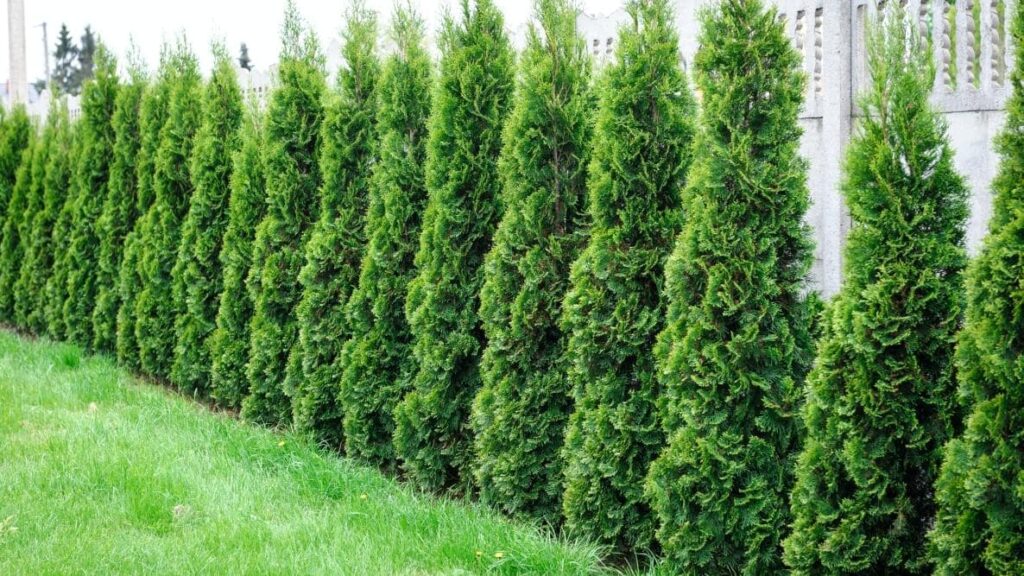
| Factor | Description |
| Ease of Growing | Easy ●○○○○ |
| Family | Cupressaceae |
| Distinctive Features | Scale-like foliage, conical or columnar growth, excellent for privacy screens |
| Possible Issues | Susceptible to deer browsing, may experience browning in severe winter conditions |
Arborvitae does well in full sun or partial shade. It can tolerate some shade but grows best in full sunlight.
These shrubs prefer well-draining soil and can adapt to various types, including clay and sandy soils. Arborvitae needs regular watering, especially when it’s getting established.
Trim them as needed to keep their shape and size. Avoid heavy pruning in late summer since new growth may not have time to toughen up before winter.
Gardeners like them because they’re easy to grow and are often used for privacy screens and hedges due to their conical or columnar growth. During severe winters, they could turn brown, but you can prevent it with proper care and protection.
Japanese Pieris (Pieris japonica)
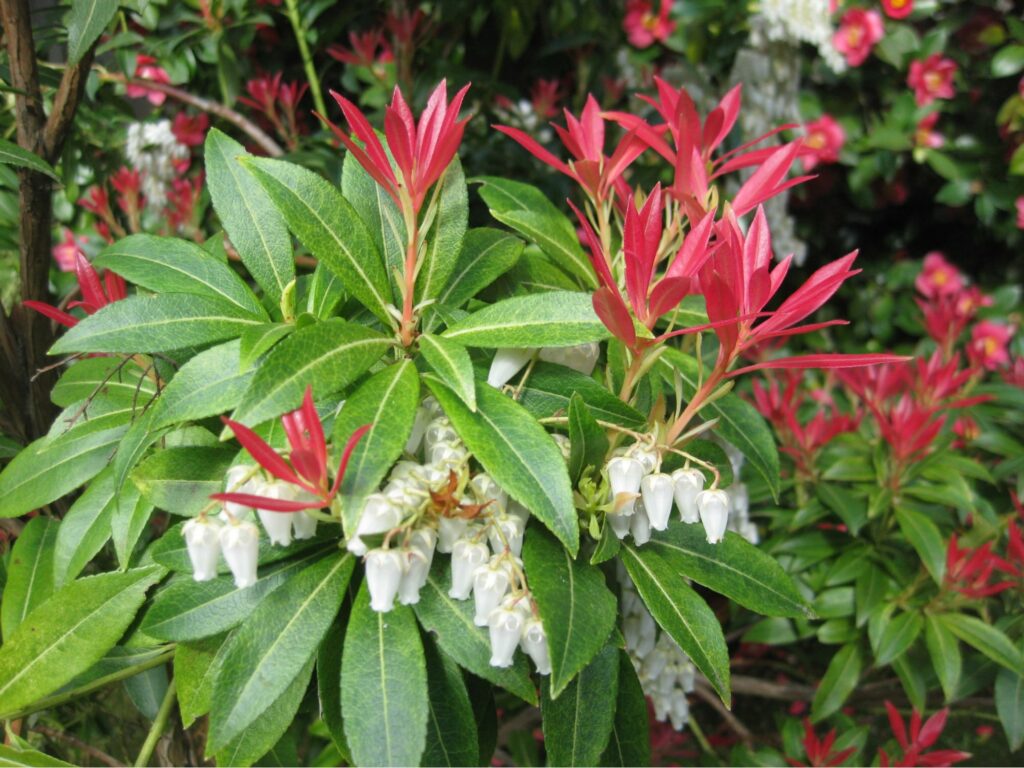
| Factor | Description |
| Ease of Growing | Moderate ●●○○○ |
| Family | Ericaceae |
| Distinctive Features | Glossy evergreen leaves, drooping clusters of white or pink flowers, attractive red new growth |
| Possible Issues | Susceptible to lace bug infestations, prefers acidic soil, can be sensitive to harsh winter conditions |
Japanese Pieris thrives in partial to full shade, preferring dappled or filtered light rather than direct sun. It needs well-draining, acidic soil with a pH between 4.5 and 6.0.
Adding peat moss can help increase acidity. Keep the soil consistently moist, especially during dry periods, but avoid overwatering.
Trim it after flowering to maintain its shape and remove dead or damaged branches. Apply acidic plant fertilizer in spring for healthy growth.
It has evergreen leaves, fragrant white or pink flowers, and red new growth in spring, making it popular for landscaping.
Mountain Laurel (Kalmia latifolia)
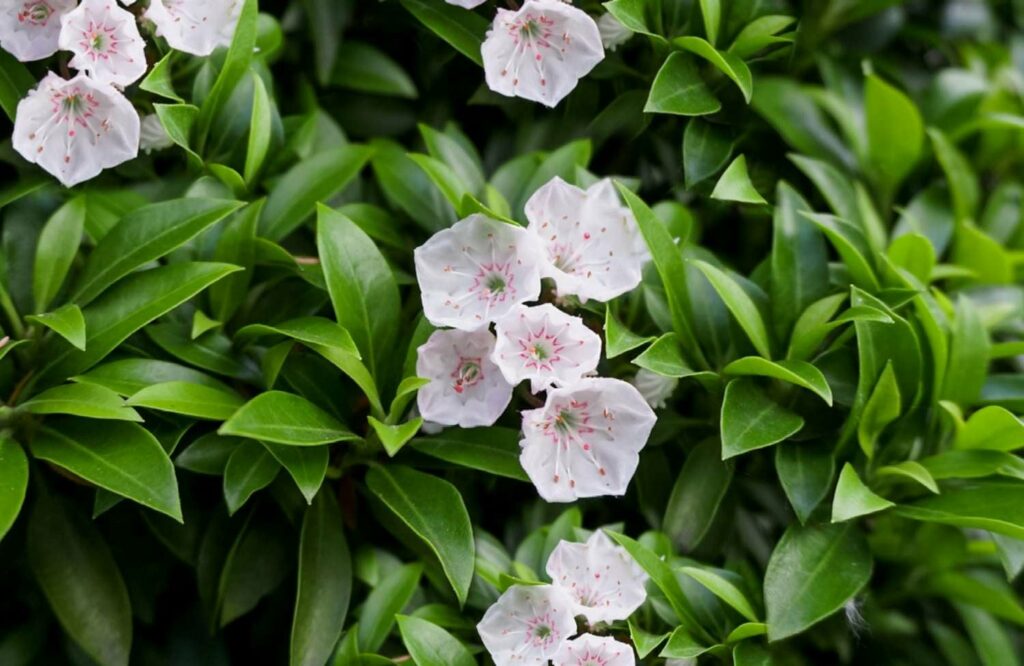
| Factor | Description |
| Ease of Growing | Moderate ●●○○○ |
| Family | Ericaceae |
| Distinctive Features | Clusters of pink or white flowers, evergreen leaves, ornamental value |
| Possible Issues | Susceptible to leaf spot, prefers acidic soil, may be slow-growing in certain conditions |
Mountain Laurel shrubs thrive in acidic soil with a pH between 4.5 and 5.5. Make sure there’s well-draining soil with adequate organic content.
They also prefer partial to full shade. They can tolerate some morning sun but generally do best in dappled shade or under taller trees.
Keep the soil consistently moist but avoid waterlogging. They’re sensitive to drought, so regular watering, especially in dry periods, is crucial.
Prune minimally, only to remove dead or diseased branches or to maintain their shape if necessary. Apply mulch around the base to retain soil moisture and acidity.
Rhododendron (Rhododendron spp.)
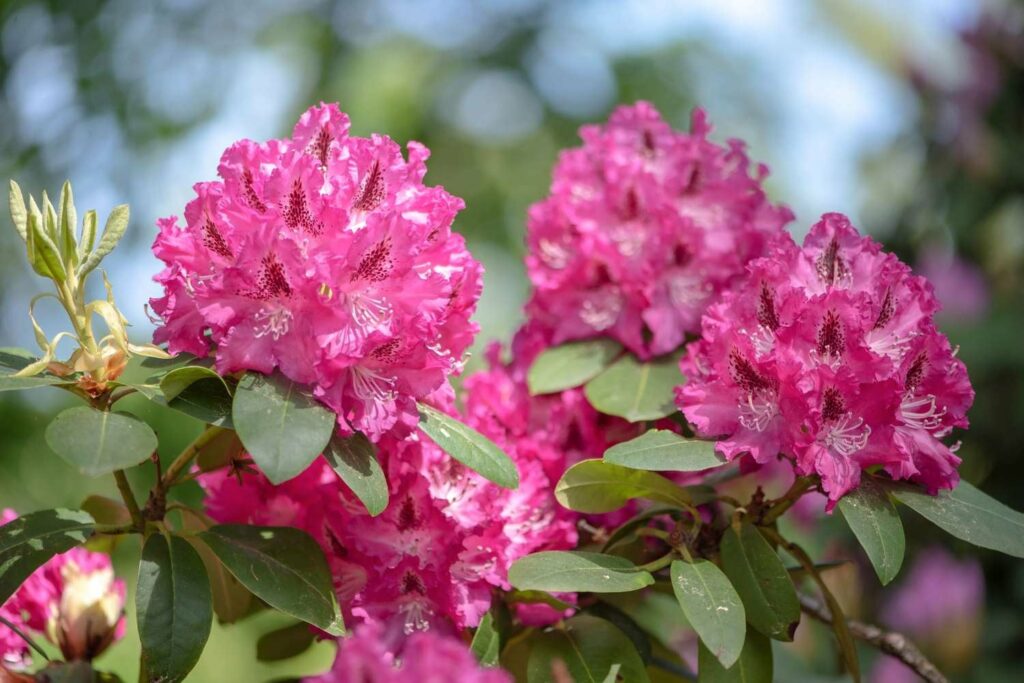
| Factor | Description |
| Ease of Growing | Moderate ●●○○○ |
| Family | Ericaceae |
| Distinctive Features | Colorful and showy clusters of flowers, evergreen or deciduous, broad-leaved, large shrubs or small trees |
| Possible Issues | Susceptible to root rot in poorly drained soils, requires acidic soil, protection from harsh winter winds |
Rhododendrons do well in filtered or dappled sunlight, especially with morning sun and afternoon shade. Avoid planting them in direct sunlight, especially in hot areas as it can harm their leaves.
Rhododendrons need well-drained, acidic soil with a pH between 4.5 and 6.0. Adding compost or peat moss can help maintain the right acidity and make sure there’s good drainage to avoid root rot.
Water regularly, especially during dry periods, but be careful not to overwater to avoid root rot. Mulching with organic material helps retain soil moisture.
Rhododendrons thrive in cooler to moderate climates. Choose cold-hardy varieties like ‘PJM’ or ‘Nova Zembla’ for Zone 5.
Andromeda (Pieris spp.)
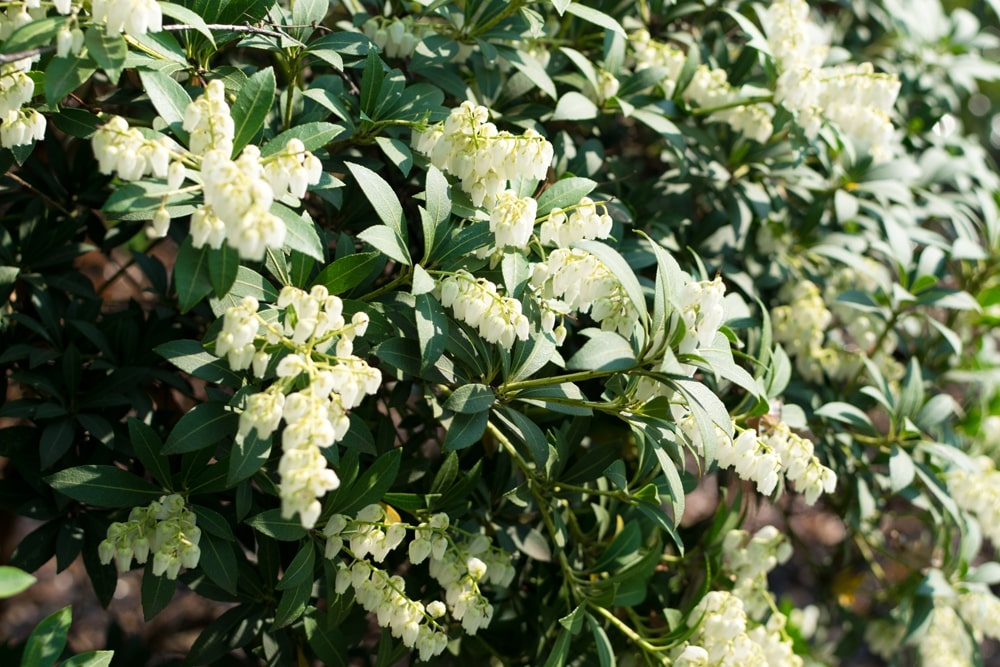
| Factor | Description |
| Ease of Growing | Moderate ●●○○○ |
| Family | Ericaceae |
| Distinctive Features | Evergreen, bell-shaped flowers (white or pink), lance-shaped leaves, compact growth habit |
| Possible Issues | Susceptible to lace bug infestations, prefers acidic soil, may require protection from harsh winters |
Andromeda does well in partial to full shade and should not be planted in intense sunlight. These shrubs thrive in well-draining, acidic soil with a pH between 5.0 and 6.5.
Keep the soil consistently moist but not waterlogged, especially during the growing season. Using mulch can help retain moisture while compost improves the structure.
Trim Andromeda after it flowers to maintain its compact growth and remove dead or damaged branches. Avoid heavy pruning to protect next year’s flower buds.
Use a balanced, slow-release fertilizer sparingly in early spring to promote healthy growth. Enjoy its lance-shaped leaves and compact growth habit as a great addition to gardens.
Dwarf Alberta Spruce (Picea glauca ‘Conica’)
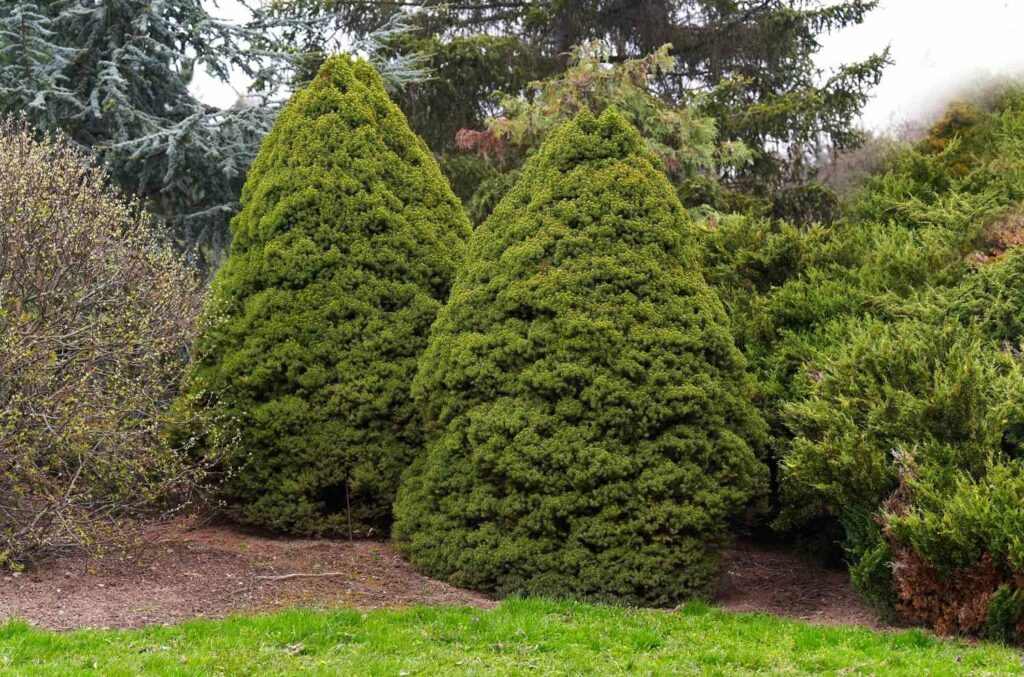
| Factor | Description |
| Ease of Growing | Moderate ●●○○○ |
| Family | Pinaceae |
| Distinctive Features | Compact, conical shape; dense foliage; slow growth; retains green needles year-round |
| Possible Issues | Vulnerable to spider mites in hot and dry conditions; may suffer from root rot in poorly-draining soil |
Dwarf Alberta Spruces do well in full sun to partial shade, needing at least 6 hours of sunlight daily. They prefer well-draining soil that’s slightly acidic to neutral to avoid root rot.
Keep the soil moist but not soaked, especially during the growing season. These spruces grow slowly, which is great for small gardens or pots.
Usually, pruning isn’t necessary as they naturally stay compact. Just trim dead or damaged branches if needed.
Wintercreeper (Euonymus fortunei)

| Factor | Description |
| Ease of Growing | Easy ●○○○○ |
| Family | Celastraceae |
| Distinctive Features | Evergreen vine, variegated foliage, groundcover or climbing vine, adaptable to various soil and light conditions |
| Possible Issues | Invasive in some regions, may require pruning to control growth |
Wintercreeper thrives in full sun and partial shade, fitting various garden settings. It prefers well-draining soil but can handle clay, loam, and sandy soils.
Once established, it’s quite drought-tolerant. Regular watering during dry spells encourages healthier growth.
This plant is hardy and can endure different temperatures, suitable for various climates. You may need to trim it to control growth, especially for ground cover or climbing vines.
It can be used as both ground cover and a climbing vine, adding beauty to gardens and landscapes. Responsible gardening can prevent it from displacing native plants in some ecosystems.
Oregon Grape Holly (Mahonia aquifolium)
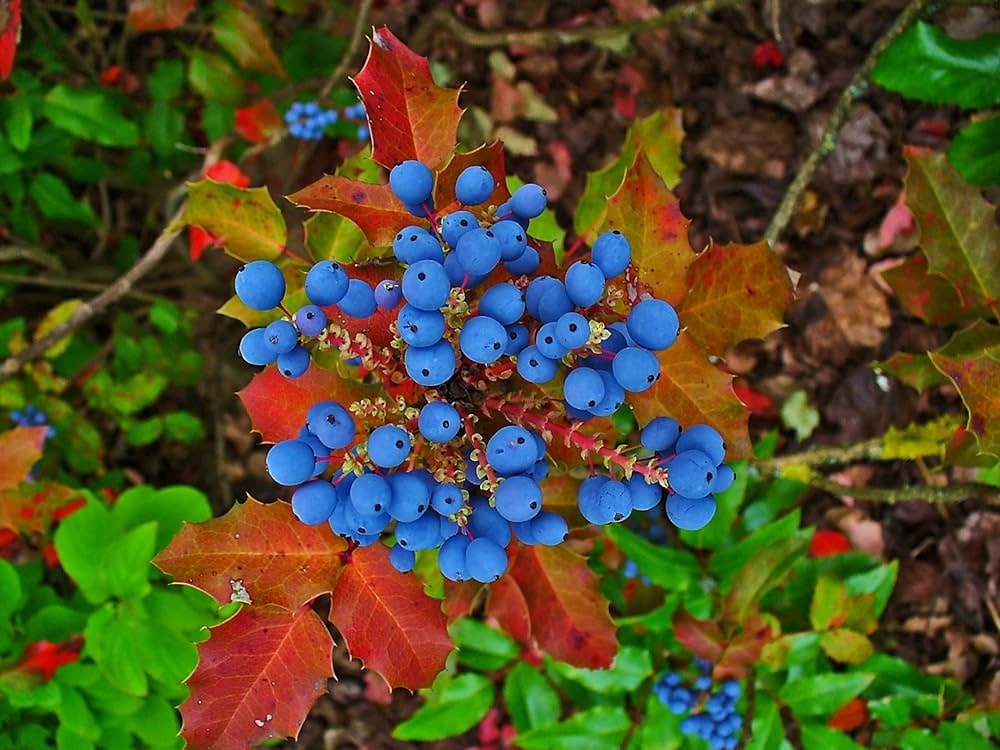
| Factor | Description |
| Ease of Growing | Moderate ●●○○○ |
| Family | Berberidaceae |
| Distinctive Features | Holly-like leaves, yellow flowers in spring, purple-blue berries, evergreen, drought tolerance, deer-resistant |
| Possible Issues | Susceptible to aphids, requires well-drained soil, can become leggy if not pruned occasionally |
Oregon Grape Holly is a versatile shrub with holly-like leaves, yellow springtime flowers, and colorful berries that thrives in partial to full shade. It can handle different light conditions but prefers dappled shade.
Use well-draining soil with good organic content. It adapts to various soil types but thrives in moist but not waterlogged soil.
Once established, it’s drought-tolerant. Water regularly during initial growth, then reduce frequency.
Trim occasionally in late winter or early spring to maintain a compact shape. It’s deer-resistant. The edible purple-blue berries in late summer are tart.
Japanese Spurge (Pachysandra terminalis)
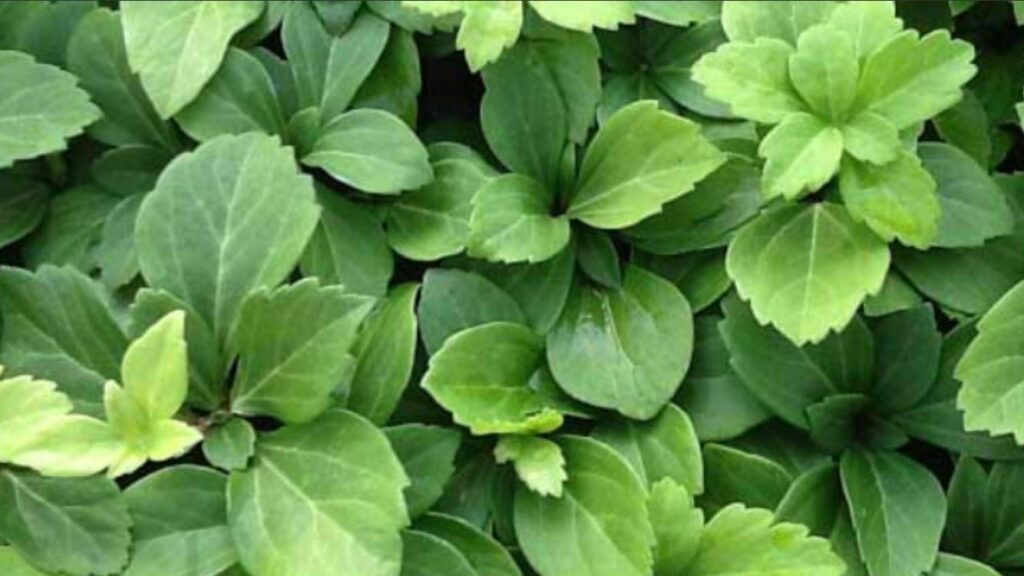
| Factor | Description |
| Ease of Growing | Easy ●○○○○ |
| Family | Buxaceae |
| Distinctive Features | Glossy evergreen leaves, low-growing ground cover, white flower spikes in spring |
| Possible Issues | Can be invasive in some regions |
Japanese Spurge thrives in partial to full shade, making it suitable for shaded garden spots. Japanese Spurge prefers well-draining, moist soil with nutrients even though it can adapt to different soils.
Keep the soil consistently moist but not soaked. Regular watering is necessary, especially during dry spells.
Plant Japanese Spurge 6 to 12 inches apart to allow for spreading and ground cover. Apply mulch around the plants to retain soil moisture and control weeds.
Lightly prune it after the spring flowering period to maintain its shape and encourage denser growth. Use a balanced, slow-release fertilizer sparingly in spring to promote healthy growth.
Inkberry Holly (Ilex glabra)
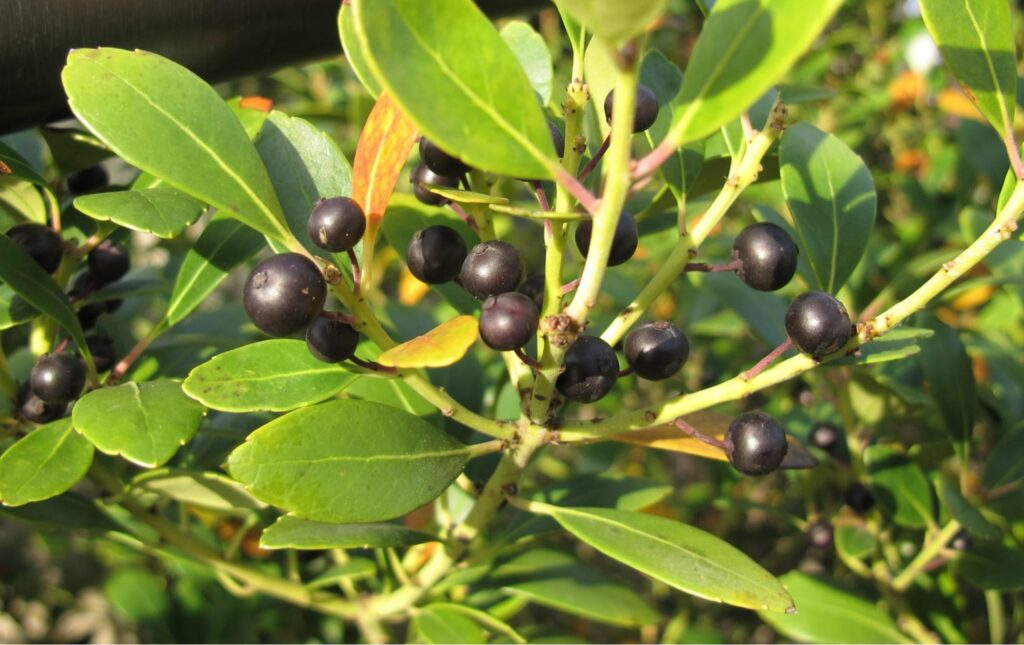
| Factor | Description |
| Ease of Growing | Moderate ●●○○○ |
| Family | Aquifoliaceae |
| Distinctive Features | Glossy evergreen leaves, small black berries, versatile landscaping shrub |
| Possible Issues | Susceptible to leaf spot disease, requires regular pruning for shape maintenance |
Inkberry Holly, scientifically known as Ilex glabra, is an evergreen shrub with glossy leaves and small black berries. It’s not the easiest plant to grow but falls in the moderate category for cultivation.
These hollies thrive in various garden settings, and adapt to different soils and moisture levels. They can handle partial shade but prefer full sun for best growth and berry production.
To keep them in shape and size, regular pruning is needed, especially for hedging or formal landscaping. Do this in late winter or early spring before new growth starts.
Watch out for leaf spot disease, which can affect the foliage. To prevent it, provide good air circulation and avoid overhead watering as moisture on leaves can promote this disease.
Blue Star Juniper (Juniperus squamata ‘Blue Star’)
| Factor | Description |
| Ease of Growing | Easy ●○○○○ |
| Family | Cupressaceae |
| Distinctive Features | Silver-blue foliage, compact and low-growing, ideal for rock gardens and borders |
| Possible Issues | Deer-resistant, drought-tolerant, low maintenance |
Sunlight: Blue Star Juniper does well in full sun to partial shade but looks best when it gets plenty of sunlight. Good drainage is important for this juniper though it can handle different soil types, including sandy or rocky soil.
Once it’s established, Blue Star Juniper doesn’t need much water. Water it deeply but not too often.
You usually don’t need to prune this compact shrub, but a light trim in early spring can keep its shape. Plant Blue Star Juniper with enough space for it to reach its mature size, which is typically around 2 feet in height and width.
It works well in rock gardens, borders, or as ground cover due to its compact growth. Blue Star Juniper is also resistant to deer and can handle drought, making it a low-maintenance addition to your yard.
Heavenly Bamboo (Nandina domestica)
| Factor | Description |
| Ease of Growing | Moderate ●●○○○ |
| Family | Berberidaceae |
| Distinctive Features | Attractive compound leaves, bright red berries in fall, multiple stems, adaptable to various garden styles |
| Possible Issues | Can become invasive in some regions, berries are toxic if ingested |
Heavenly Bamboo grows well in partial to full sun and can tolerate some shade. It thrives in well-draining soil with average fertility and can adapt to different soil types.
While it can handle moderate drought once established, regular watering helps it grow best. Trim as needed to maintain its shape and size by removing dead or damaged stems in late winter or early spring.
Heavenly Bamboo has attractive compound leaves and remains visually appealing throughout the year. In the fall, it produces vibrant red berries, adding a pop of color to your landscape.
However, it can become invasive in some regions due to self-seeding so regularly removing unwanted seedlings can help prevent this issue. Be aware that the berries are toxic if ingested, so be mindful if you have children or pets in your garden.
Dwarf Hinoki Cypress (Chamaecyparis obtusa ‘Nana Gracilis’)
| Factor | Description |
| Ease of Growing | Moderate ●●○○○ |
| Family | Cupressaceae |
| Distinctive Features | Compact, evergreen foliage; conical growth habit; slow growth rate |
| Possible Issues | Susceptible to certain pests and diseases, such as spider mites and root rot |
The Dwarf Hinoki Cypressis compact and has gracefully arching green foliage that stays green all year. It’s great for small gardens, rockeries, or containers because it grows slowly in a conical shape.
It likes partial to full sun, around 4 to 6 hours of direct sunlight a day. Good drainage is vital. Make sure the soil doesn’t get waterlogged to prevent root rot.
Watering: Keep the soil consistently moist, especially in the first year. It can handle some drought but still needs regular watering in dry spells.
You can trim it to keep its shape or size, but it usually doesn’t need much because it grows slowly. In the spring, give it some balanced fertilizer once a year to help it grow well.
Japanese Holly (Ilex crenata)
| Factor | Description |
| Ease of Growing | Moderate ●●○○○ |
| Family | Aquifoliaceae |
| Distinctive Features | Small, glossy, dark green leaves; compact growth habit; suitable for hedges and topiaries; berries on female plants |
| Possible Issues | Susceptible to pests and diseases; requires well-drained soil |
Japanese Holly prefers partial to full sun but can tolerate partial shade so make sure they get at least 4 to 6 hours of sunlight daily. These shrubs do well in well-draining slightly acidic to neutral soil, so add organic matter to improve soil fertility and drainage.
Keep the soil consistently moist, but avoid overwatering as Japanese Holly doesn’t like waterlogged soil. Female Japanese Holly plants produce small berries attractive to birds so if you want berries, make sure you have both male and female plants for pollination.
Regularly trim to maintain a compact shape and encourage bushier growth, so prune in late winter or early spring before new growth. Use a balanced, slow-release fertilizer in early spring to provide necessary nutrients.
Russian Cypress (Microbiota decussata)
| Factor | Description |
| Ease of Growing | Easy ●○○○○ |
| Family | Cupressaceae |
| Distinctive Features | Feathery, dark green foliage, low-spreading habit, excellent ground cover |
| Possible Issues | Drought-sensitive, may experience winter burn in harsh climates |
Russian Cypress is a tough evergreen shrub in the Cupressaceae family. It’s well-liked for its ease of growth in gardens.
Russian Cypress has dark green, feathery foliage that stands out in gardens. It spreads close to the ground, making it great for ground cover in weed-prone areas.
But, it’s sensitive to drought, so remember to water it well, especially in dry times. In harsh winters, it might get brown due to cold winds; sheltered planting or anti-desiccant sprays can help.
It needs well-drained soil with moderate moisture and prefers partial to full sun. You usually won’t need to prune it since it keeps its shape naturally.
Dwarf Blue Spruce (Picea pungens ‘Montgomery’)
| Factor | Description |
| Ease of Growing | Moderate ●●○○○ |
| Family | Pinaceae |
| Distinctive Features | Compact size, blue-green needles, conical shape, ornamental value |
| Possible Issues | Susceptible to spider mites, prefers well-drained soil, occasional browning of needles |
The Dwarf Blue Spruce prefers well-draining soil to avoid root rot, so choose a suitable planting spot. While its needles usually keep their vibrant color, they can occasionally turn brown due to factors like drought or harsh winters.
Trimming damaged branches and providing enough water during dry spells can help maintain the shrub’s appearance. The Dwarf Blue Spruce does well in full sun to partial shade, needing 4 to 6 hours of direct sunlight daily.
It thrives in well-draining soil that’s slightly acidic to neutral. Regular watering is necessary, especially during the establishment phase but once established, it can tolerate some drought.
Minimal pruning is needed, mainly to remove dead or damaged branches, usually done in late winter or early spring. Lightly fertilize it in early spring with a balanced, slow-release fertilizer for healthy growth.
Korean Boxwood (Buxus microphylla)

| Factor | Description |
| Ease of Growing | Moderate ●●○○○ |
| Family | Buxaceae |
| Distinctive Features | Small, glossy leaves, compact growth habit, suitable for hedges and topiaries |
| Possible Issues | Susceptible to boxwood blight disease, occasional pest problems |
Korean Boxwood has small, shiny leaves and a compact growth pattern, making it popular for hedges and topiaries. They do well in partial to full sun so six hours of daily sunlight is ideal even though they can tolerate some shade.
Plant them in well-draining soil that is slightly acidic to neutral and retains moisture, so adding organic matter can improve the soil quality. Maintain consistent soil moisture without overwatering, so deep watering is better than frequent shallow watering.
Trim them in late winter or early spring to maintain their shape and encourage dense growth, preventing legginess. Use a balanced, slow-release fertilizer in the spring, avoiding excessive fertilization, which can lead to disease susceptibility.
Watch for signs of boxwood blight like leaf spots and dieback. If you spot it, promptly remove and dispose of affected plant parts to prevent further spread.
Canadian Hemlock (Tsuga canadensis)
| Factor | Description |
| Ease of Growing | Moderate ●●○○○ |
| Family | Pinaceae |
| Distinctive Features | Soft, feathery needles; conical shape; tolerance to shade; elegant and graceful appearance |
| Possible Issues | Susceptible to certain pests like adelgids and hemlock woolly adelgids; needs well-drained soil |
Canadian Hemlock does best in well-draining, slightly acidic, and moist soil. Make sure the soil doesn’t get waterlogged to avoid root rot.
Keep the soil consistently moist, especially during dry periods so don’t let it dry out completely. It can handle cold winters but struggles in hot, dry conditions so shield it from extreme heat and use mulch to retain moisture.
Only prune to maintain its natural shape; too much can stress the plant. Give it enough space for proper air circulation, preventing overcrowding.
Generally, it doesn’t need heavy fertilization as organic mulch can provide nutrients and retain moisture. Canadian Hemlock has soft needles and an elegant appearance, making it a great addition to shaded garden areas.
Japanese Skimmia (Skimmia japonica)
| Factor | Description |
| Ease of Growing | Moderate ●●○○○ |
| Family | Rutaceae |
| Distinctive Features | Glossy evergreen leaves, fragrant flowers, colorful berries, compact growth habit |
| Possible Issues | Susceptible to scale insects, prefers acidic soil, may require protection from harsh winters |
Japanese Skimmia is valued for it for its shiny evergreen leaves, sweet-smelling flowers, colorful berries, and compact size. Plant it in partial to full shade as it can handle some morning sun, but it prefers shaded or filtered light, especially in hot areas.
This shrub does best in well-draining, slightly acidic soil. Keep the soil consistently moist, but don’t let it become waterlogged and mulch around the shrub instead as this organic layer can help retain moisture and insulate against extreme temperatures.
Trim it in early spring to maintain its compact shape and remove any dead or diseased branches. Use a balanced, slow-release fertilizer in the spring to encourage healthy growth and berry production.
Watch out for scale insects, which can infest Japanese Skimmia. If you spot them, treat the plant promptly with insecticidal soap or horticultural oil.
Eastern Red Cedar (Juniperus virginiana)
| Factor | Description |
| Ease of Growing | Moderate ●●○○○ |
| Family | Cupressaceae |
| Distinctive Features | Scale-like foliage, red-brown bark, conical shape, aromatic wood, blue berry-like cones |
| Possible Issues | Susceptible to cedar rust, deer browse |
The Eastern Red Cedar has scale-like, green, and aromatic leaves with red-brown, peeling bark that adds a nice touch to the landscape. They naturally grow in a cone shape, making them great for hedges or ornamental planting.
The wood of Eastern Red Cedar is fragrant and often used in cedar chests and closets. They produce attractive blue, berry-like cones.
Eastern Red Cedars thrive in full sun but can handle some shade. They like well-drained soil, including sandy or loamy types, and can tolerate various soil pH levels.
Once established, they can endure dry periods but benefit from occasional watering. Pruning can help maintain their desired appearance, especially if they’re used for hedges or topiaries.
Blueberry Bushes (Vaccinium spp.)
| Factor | Description |
| Ease of Growing | Moderate ●●○○○ |
| Family | Ericaceae |
| Distinctive Features | Edible berries, colorful foliage (varies by species), deciduous, bell-shaped flowers |
| Possible Issues | Soil acidity requirements, bird attraction (may require netting to protect berries) |
Blueberry bushes are beloved by home gardeners for their tasty and nutritious berries. These bushes lose their leaves in the fall, often with colorful foliage before that and they also produce bell-shaped flowers in the spring.
Blueberry bushes thrive in acidic soil, typically with a pH of 4.5 to 5.5. Meeting this requirement can be challenging in areas with naturally alkaline soil but is crucial for the bushes’ health and productivity.
Birds are drawn to blueberries and may eat them before you can harvest them. Protect the berries with nets or other deterrents.
Make sure the soil acidity is right and maintain consistent moisture. Regular pruning, proper spacing, and ongoing care are pretty important for healthy, fruitful blueberry bushes.
Japanese False Cypress (Chamaecyparis pisifera)
| Factor | Description |
| Ease of Growing | Moderate ●●○○○ |
| Family | Cupressaceae |
| Distinctive Features | Feathery, blue-green foliage, graceful appearance, conical shape |
| Possible Issues | Susceptible to certain pests and diseases |
Japanese False Cypress prefers full to partial sun and well-drained soil. Watch out for common pests like spider mites and aphids, and ensure good air circulation to prevent fungal diseases.
Keep the soil consistently moist, especially during the establishment phase. Once established, they can handle some drought.
While not required, you can prune them for shaping or size control. Prune in late winter or early spring before new growth.
Applying mulch around the base helps maintain soil moisture and temperature. They’re typically hardy in USDA zones 4 to 8.





